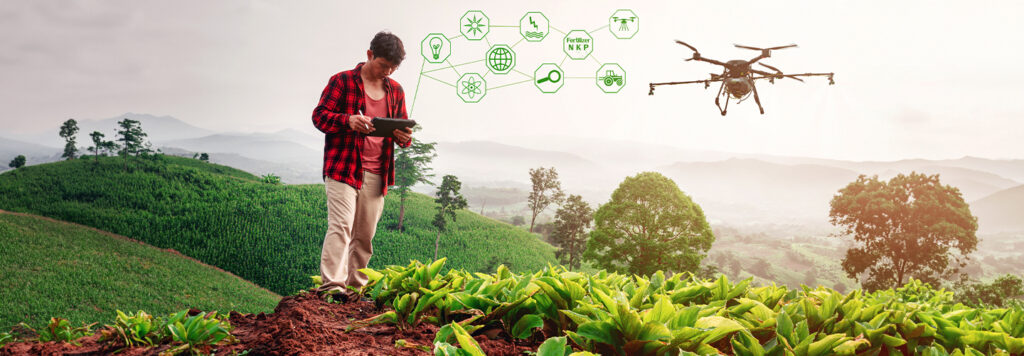Harvesting Innovation: How Agriculture Software is Contributing to Sustainable Farming Practices

Today, the world is undoubtedly on the brink of an environmental crisis, and the role of technology, especially agriculture software, in shaping the future of farming has never been more critical. The agricultural sector stands as both a victim and a solution to the myriad of challenges plaguing the planet – from soil degradation and water scarcity to the relentless impacts of climate change.
Thus, the urgency for sustainable farming practices has become undeniable. Environmental challenges, such as the depletion of arable land and freshwater resources, coupled with the looming threats of climate change, cast long shadows over the agricultural landscape. Moreover, the economic and social implications of failing to address these challenges are vast, encompassing food security, farmer livelihoods, and the well-being of rural communities.
The digital era of agriculture, however, is proving how technologies and agriculture software are not merely tools but catalysts for change, fostering sustainability and enabling the world’s population to secure their future of food.
This article delves into a transformative narrative, one where lines of code and algorithms are taking root amidst fields and farmlands, revolutionizing the way we produce food.
The Imperative for Sustainable Farming
As we delve deeper into the existing agricultural practices following a sequential revolution, the importance of sustainability has become a key concern that transcends the boundaries of agriculture itself. To comprehend the gravity of this importance, it is necessary to understand the key challenges.
At the heart of the sustainability challenge lies the alarming state of the environment. Soil degradation, brought about by aggressive agricultural practices, threatens to erode the capacity to produce food. Water scarcity has also become more visible as aquifers deplete and climate change alters precipitation patterns. Climate change, on the other hand, brings to the fore extreme weather events and shifts growing seasons disrupting traditional farming calendars.
Sustainability compels farmers and agricultural companies to undertake a fundamental reassessment of their relationship with land, water, and climate. Moreover, it helps embrace innovation and harness technologies as a force for nurturing farming practices that improve yields without impacting the environment.
Cultivating Sustainability Through Agriculture Software and Digital Solutions
As with other industries, the boundaries between agriculture and technology are rapidly dissolving, and the adoption of sustainability in farming practices has found a powerful ally in innovative agricultural software and digital solutions.
The Rise and Evolution of Agricultural Software
Agricultural software has revolutionized farming by transitioning from labor-intensive, traditional methods to precision agriculture. Farmers now have access to tools and systems that enable them to fine-tune their farming practices, minimizing waste and maximizing efficiency.
Additionally, Internet of Things (IoT) devices and sensors have permeated the agricultural landscape, creating a network of interconnected devices that gather real-time data on crop conditions, soil moisture levels, and machinery performance, offering invaluable insights for decision-making.
Furthermore, automated machinery and robotics streamline farming operations, reducing human labor and minimizing the environmental impact of farming activities.
The Power of AI-driven Agriculture Software
AI is at the forefront of the agricultural sustainability revolution, promoting both environmental conservation and the economic viability of farming operations. The power of AI-driven agriculture software lies in its ability to harness vast amounts of data, analyze it in real time, and provide actionable insights that empower farmers to make sustainable choices.
Crop Management
- Real-time Monitoring and Analysis: AI-powered agriculture software continuously monitors crop conditions using a myriad of data sources, including satellite imagery, drones, and ground sensors. This real-time data collection enables farmers to make informed decisions about irrigation, fertilization, and pest control.
- Precision Agriculture: AI algorithms process vast datasets to create detailed field maps, highlighting variations in soil quality and crop health. Farmers can then apply resources precisely where needed, reducing waste, conserving resources, and optimizing yields.
- Climate Resilience: AI assists in adapting to changing climate conditions by offering insights into how crops respond to varying environmental factors. This knowledge allows farmers to adjust planting schedules and crop varieties to mitigate climate-related risks.
Pest and Disease Detection
- Early Warning Systems: AI-powered image recognition and data analysis can identify subtle signs of pests and diseases that might be imperceptible to the human eye. Early detection enables farmers to take swift action, minimizing crop losses and reducing the reliance on chemical treatments.
- Reduction in Chemical Use: By pinpointing affected areas and recommending targeted interventions, AI helps reduce the overall use of pesticides and herbicides, promoting environmentally friendly and sustainable pest management practices.
Weather Forecasting
- Hyper-local Predictions: AI-driven weather models offer hyper-localized forecasts that consider a farm’s precise location. This level of granularity allows farmers to make critical decisions about planting, irrigation, and harvest timing with unparalleled accuracy.
- Resilience to Climate Change: AI’s ability to analyze historical climate data and predict future trends equips farmers with strategies to adapt to changing weather patterns and extreme events, ultimately enhancing resilience in the face of climate change.
Resource Optimization
- Water Management: AI algorithms optimize irrigation schedules, taking into account real-time soil moisture data and weather predictions. This results in substantial water savings and reduces the environmental impact of agriculture.
- Fertilizer Efficiency: AI-driven systems recommend optimal fertilizer application rates based on soil nutrient levels and crop requirements, reducing excess fertilizer usage and minimizing nutrient runoff, a significant contributor to water pollution.
Agriculture Software for Sustainable Farming Practices: The Path Forward
The journey toward sustainable farming practices facilitated by agricultural software is an evolving process that relies heavily on continuous innovation. Therefore, it is important to stay at the forefront of technology and adapt to changing circumstances.
As technology advances, farmers and agricultural companies are embracing agriculture software equipped with new and emerging technologies that have the potential to further enhance sustainability. For instance, Blockchain can be used to improve supply chain transparency, traceability, and food safety. By enabling consumers and producers to track the journey of agricultural products, it promotes trust and ensures the authenticity of sustainable claims.
Adaptability is also emerging as a key feature in agriculture software. Algorithms used in agricultural software should be flexible enough to accommodate changing environmental conditions and evolving farming practices. This adaptability ensures that recommendations remain relevant over time. Moreover, seamless integration with various data sources and allowing for the incorporation of new data streams, such as climate data, satellite imagery, or market trends, are important to provide comprehensive insights.
FarmERP is a cutting-edge agricultural software solution that revolutionizes sustainable farming. It empowers farmers with precise data analytics, real-time monitoring, and AI-driven insights, facilitating resource-efficient practices.
If you’re a farmer, agricultural stakeholder, or enthusiast, take the initiative to explore FarmERP’s capabilities. Contact us to learn how it can enhance your farming practices, improve resource management, and contribute to sustainability.
